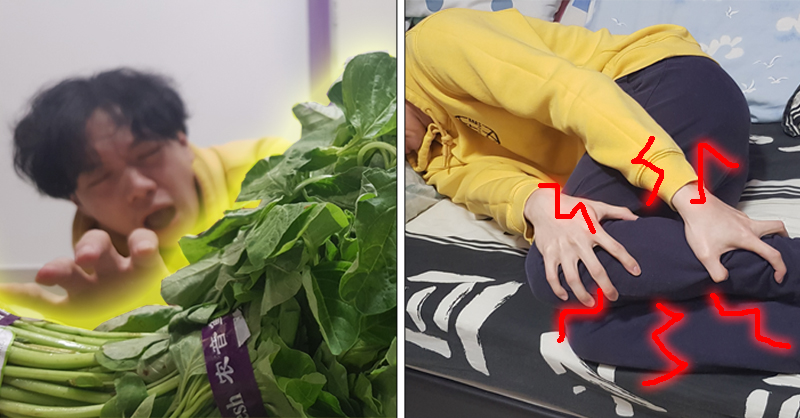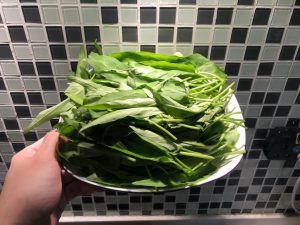Does eating too much kangkung cause leg cramps? We force fed our intern to find out.

- 560Shares
- Facebook520
- Twitter12
- LinkedIn7
- Email5
- WhatsApp16
Ever heard your parents or uncle and aunties talk about kangkung causing nocturnal leg cramps because it’s a “cooling” food? If you grew up in a Chinese household, there’s a chance that you might’ve. Before you pooh-pooh the idea of a vegetable giving you midnight cramps, the concept of “heaty” and “cooling” foods is a mainstay of TCM which basically suggests that our body requires a balance of “heaty” (yang) and “cooling” (yin) energies, and eating too much of anything that’s either “heaty” or “cooling” in nature is bad for you.
A licensed traditional Chinese medicine (TCM) practitioner from Singapore under the pen name Mantologue explained it thusly:
“…due to the cooling nature of water spinach (kangkung), excessive consumption can easily form the pathogenic cold which accumulates to form stagnation in the qi and blood, causing inadequate blood supply to the legs therefore can lead to cramps.” – Mantologue

While that sounds plausible, we wanted to hear from a nutritionist, so we called up Dr. Tan Sue Yee. She’s got 8 years of experience working in private sectors as a nutritionist, and she has contributed to MOH’s nutrition division as an expert panelist. When we asked Dr. Tan whether she’s heard of this kangkung leg cramp thing, she said she had. Alright, score. The next thing we asked her was…
How much kangkung should our intern eat to get leg cramps?

Before we go into the methodology of the “experiment”, a smol disclaimer: We let the him eat other stuff also lah besides JUST kangkung, we’re not that crazy. Our intern had a fairly balanced diet over the course of the experiment, but for the fact that he had 140g of kangkung as the main dish three times a day.
According to Dr. Tan, a person’s daily food intake, how the food is cooked, how long they sleep and activities are huge factors to how the body could react to kangkung, and a normal person typically consumes about 70g of vegetables per meal. So, we had our lab rat (or our intern, whatever you wanna call him) do this over the span of 3 days to try to minimize any variables and keep external factors as consistent as possible:
- Double up on vegetable intake with 140g KANGKUNG per meal.
- Sleep for 6 hours each day.
- No exercising (to make sure any leg cramps were from the kangkung).
- See how many times the intern wakes up in his sleep due to leg cramps.
Unfortunately…
He ended up with ZERO leg cramps

On day one of the experiment, our intern said that his legs didn’t feel unusual in his sleep. Well, there’s two more days of kangkung konsumption to go, maybe he just needed more of the green stuff in his tummy.
Eating another 420g of the vegetable on day two seemed to do the trick – although it wasn’t in his sleep, he said he could feel a slight tingle in his left leg throughout the next day. Then again, it could’ve been because he spent a lot of time standing up while cooking and doing other chores around the house. The leg tingle didn’t happen in his sleep, so we guess that technically doesn’t count.
Sadly, downing the last batch of kangkung did not prove fruitful (it was vege-ful tho). Our intern had a peaceful night’s sleep with no cramps in sight or in his legs. We should be happy that he didn’t have to jolt up in his bed writhing in pain, but just this once we were hoping for something different, in the name of science!
TL;DR: Three days and a grand total of 1260g of Kangkung did not give our intern leg cramps in the middle of the night. That’s a lot of kangkung for any one person to eat in such a short amount of time, so what’s the deal? It turns out…
Your lifestyle is what’s giving you leg cramps at night, not kangkung

According to Dr. Tan, there’s no harm in eating too much kangkung… besides indigestion. The whole leg cramp “myth” is more about a person’s diet contributing to how that their body reacts to certain amounts of food/nutrients, and less about kangkung being a supernatural leg cramping food.
“Everybody has a different reaction with their body, and it has a lot to do with their daily diet with the nutrients involved,” – Dr. Tan, in her interview with CILISOS
Dr. Tan also said that the vegetable is only dangerous if it’s not properly washed prior to cooking because there could still be leftover pesticides from whichever farm the kangkung came from, and a person’s sleeping position could be a strong factor that comes into play when we’re talking about getting leg cramps in bed. Certain positions when sleeping can suppress particular nerves, thus causing leg cramps to happen.
If you’re an athlete or someone who works out a lot, overworking your muscles and not properly warming up/cooling down after exercising may affect you when you are trying to rest. Other ailments like kidney failure and diabetic nerve damage that have nothing to do with what vegetables you eat also have nocturnal leg cramps as one of their symptoms.
Having said all that…
Kangkung is actually HELPFUL towards preventing leg cramps
If we were to talk about all the nutritional benefits found in kangkung, we’d be here for awhile, but the gist of it is that it’s rich in antioxidants, minerals, and a variety of vitamins, particularly Vitamin A and Vitamin C. We wanna bring special attention to Vitamin C, because it helps in the absorption of iron by the body. Remember the thing about RLS and iron deficiency? Yeah, kangkung helps with that. Plus, it’s rich in magnesium and potassium, the deficiency of which can lead to more frequent cramp episodes.
Long story short, kangkung is good for you… so if you’re suffering from chronic leg cramps , maybe you should let Kangkung give you a hand, or rather, a leg.
- 560Shares
- Facebook520
- Twitter12
- LinkedIn7
- Email5
- WhatsApp16




